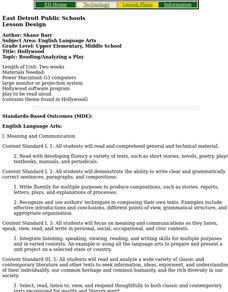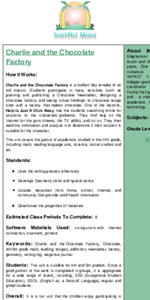Curated OER
Presentation of Our Family
Although there is no real lesson plan included here, you could easily recycle the idea! Get kids using vocabulary related to family, age, feelings, and nationality. Start by teaching basic vocabulary words and phrases (you'll need to...
Curated OER
Assessing Presenting the Mask
Eighth graders use a software program to recreate a mask they made in art class. Individually, they write a paper describing their mask with an loose illustration. They combine the pictures of each mask into a class book for others to view.
Curated OER
Hollywood
Pupils listen to a play, or perhaps, take turns reading portions of it aloud. Afterward, they thoughtfully analyze and discuss the components of a well-written play. Next, a theme is assigned, and each person writes a play in conjunction...
Curated OER
Vocabulary: Variety and Venture
Young scholars locate the definitions and synonyms using a variety of activities that involve handheld computers and specific software. They read and discuss definitions, and create an illustration/animation for assigned words.
Curated OER
Have I Got a Graphic Organizer for You
Use Inspiration software to create webs. You have to create discussion topics (none are provided here), but learners will enjoy working with pairs and technology.
Teach Engineering
Complex Networks and Graphs
Show your class how engineers use graphs to understand large and complex systems. The resource provides the beginnings of graph theory by introducing the class to set theory, graphs, and degree distributions of a graph.
Bowland
AstroZoo
Rescue animals in the zoo by applying math concepts. Groups of learners solve three missions involving oxygen, food, and climate control. Each group selects an animal from one of four bio-domes.
Curated OER
Lesson 1- Set Design
Line, shape, color, texture, space. The first in a three-part series of lessons intended for advanced theatre arts classes introduces the elements of set design. Class members examine maquettes and analyze how designers have put together...
Concord Consortium
Crossing the Axis
Mathematicians typically reference eight different types of functions. Scholars learn about the requirements for graphing a function and must decide how many different functions fit. To finish, they define each specific function meeting...
Teach Engineering
Android Acceleration
Prepare to accelerate your Android. Pupils prep for the upcoming activity in this third installment of a four-part series. The lesson plan progresses nicely by first introducing different types of acceleration to the class. The teacher...
Drexel University
Learning Roomba Module 1: Robotics Introduction
Introducing Mr. Robot. As an introduction to robotics, class develop a definition of a robot and make distinctions between real robots and those in science fiction. They also study the basics of programming in Java to...
Drexel University
Learning Roomba Module 4: Sensors and Actuators
Introduce your classes to sensors and actuators in robots — specifically to the Roomba. Pupils develop programs that make Roomba utilize its different sensors.
Starry Night Education
The Year and Seasons
Turn your classroom into a live demonstration of how the earth and sun interact to create the four seasons. Using a globe, a light source, and a series of constellation cards, super scientists discover how the...
EngageNY
Estimating Probability Distributions Empirically 1
What if you don't have theoretical probabilities with which to create probability distributions? The 11th installment of a 21-part module has scholars collecting data through a survey. The results of the survey provide empirical data to...
Virginia Department of Education
Transformations
The coordinate plane is a popular place! Identify rotations, reflections, and dilations on the coordinate plane. Pupils work in small groups to match transformations of a figure with the description of the transformation....
Starry Night Education
The Stars
Three astronomy activities in one resource! Here you will find one hands-on activity, one demonstration, both with discussion questions, and one activity worksheet. During these lessons young scientists discuss how stars are...
LABScI
Kinematics: The Gravity Lab
Falling objects can be brutal if you don't protect your noodle! Scholars explore the motion of falling objects through measuring short intervals to determine if the distance traveled varies with time. Building off of this, scholars...
Curated OER
NTeQ Science Lesson
Students produce a report on the types of dinosaurs found in our state of Texas using a word processing software.
Curated OER
Symmetrical Shapes
Students find symmertical shapes around their school. In this symmetry instructional activity, students create symmetrical shapes. Students print symmetrical shapes from Kidworks Deluxe and take pictures of objects around their school...
Curated OER
The Circle of Life: Food Chain
Students develop a flow chart using computer software to show a food chain combination. For this food chain lesson, students are first read The Great Kapok Tree by Lynne Cherry, then they create a story map of the story. ...
Curated OER
An Opportunity to access and use the Internet for Research and Study.
Students analyze how to begin hands on research for science projects and experiments. They develop a problem and design a systematic effort to resolve it.
Curated OER
And the Moral of the Story is...
Students retell a story using computer software. In this story elements lesson, students retell the story giving the plot, setting, characters and moral using Pixie software.
Curated OER
Power Point Presentation
Learners use multimedia to create presentations. The national technology standards are used to have a foundation for technology usage. The users of this lesson plan should be technology literate before attempting the preparation.
Curated OER
Charlie and the Chocolate Factory
Fifth graders participate in a variety of math and language arts activities based on chocolate.























